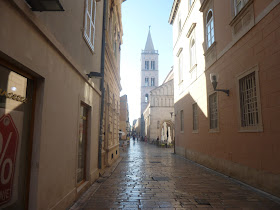After a month at sea on Azamara Quest this summer, dining on the wonderful food cooked by the only other Italian on board, Chef Fabio from Sicily, we were completely spoiled and not interested in venturing out to any local restaurants.
 |
| spaghetti con le vongole |
 |
| Symbol of Tarquinia, the Winged Horses |
But a work day organizing book sales at museums and tourist offices in the seaside town of Tarquinia was a good excuse to take a walk on the beach.
The magnificent early autumn days were another reason to escape work mode and stop in Tarquinia for lunch .
 |
| entrance area, just beside the Tarquinia railway station |
The numerous seafront restaurants at Tarquinia Lido were all closed up tight, for it was a Thursday, and this late in the season they open only on weekends when the Romani descend on surrounding seaside towns and restaurants, most of them yearning for a plate of fritto misto or spaghetti alle vongole.
 |
| fritto misto calamari, gamberi, roasted potatoes, local Cerveteri wine |
 |
| main dining area - we are the first to arrive |
Luckily Fulvio knows the area well, having worked for many years as administrator in the local hospital.
He remembered that the locals often went to a place called Da Mondino, hidden inbetween the railway station and an overpass, not a very elegant location but very popular with local business owners for lunch break.
 |
| view of the overpass, from Da Mondino |
 |
| hungry firefighters start to gather |
A large, kitsch fountain could be seen from atop the overpass, and after a few minutes trying to find the entrance, we pulled into a parking space under the overpass, next to a fire truck.
Passing near the kitchen a whiff of delicious fish told me it was open for business and along with the fire fighters we were the first to arrive.
In a few minutes an elderly curved gentleman sauntered in and headed to his corner table, greeted warmly by everyone.
 |
| vintage details |
The official name of the restaurant is Al Passo del Cacciatore, but everyone knows it as Mondino's, from the name of the owner, originally from Sardegna: Edomondo, shortened to Mondino.
 |
| trees, fountains and entrance to Da Mondino |
The place quickly filled up and by 1 p.m. most tables were full and the waiter and kitchen staff bustled around, doing what they have done for decades, cooking and serving hearty local dishes.
It was a business crowd on lunch break but they were also interested in eating well, like all Italians.
 |
| the tables start filling up |
 |
| fireplace and door to the kitchen |
Mondino's photo hangs over the kitchen door and a battery of well used aluminum cooking pots line the kitchen wall.
His sons, helped by a very professional waiter, run the place and they have spruced up the unassuming building over the years, adding an events hall at the rear along with a children's play area and fountains.
 |
| green gardens, playground, fountains and magnolia trees |
Great day out, excellent price/quality ratio. We spent 33 euro for an excellent lunch with wine, mineral water and a sorbetto al limone.









